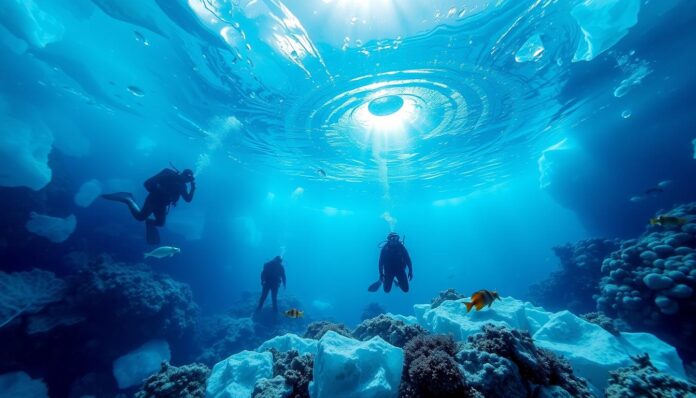| Best Time to Travel | December to February |
| What to Expect | Cold water, clear visibility, unique marine life |
| Diving Conditions | Year-round, but best from December to February |
| Marine Life | Krill, penguins, seals, whales, fish |
Have you ever wondered what secrets lie beneath Antarctica’s icy waters? Scuba diving here is an incredible journey for seasoned explorers.
Exploring Antarctica’s underwater world is a stunning adventure. The Antarctic Peninsula offers a unique chance to see an underwater world rarely seen by humans.
Imagine diving in waters that are -5 to 8°C. You’ll see incredible marine life. Scuba diving in Antarctica is more than an adventure. It’s a rare chance to see an untouched ecosystem full of unique creatures like Gentoo penguins, humpback whales, and Commerson’s dolphins.
Key Takeaways – Scuba Diving in Antarctica
- Unique diving destination with extreme environmental conditions
- Maximum dive depth of approximately 20 meters (65 feet)
- Requires minimum 30 logged dry-suit dive experience
- Voyages typically range from 12 to 23 days
- Wildlife encounters include multiple whale and penguin species
- Dive trips start at $7,700 for a 12-day expedition
- Limited to 24 diving passengers per voyage
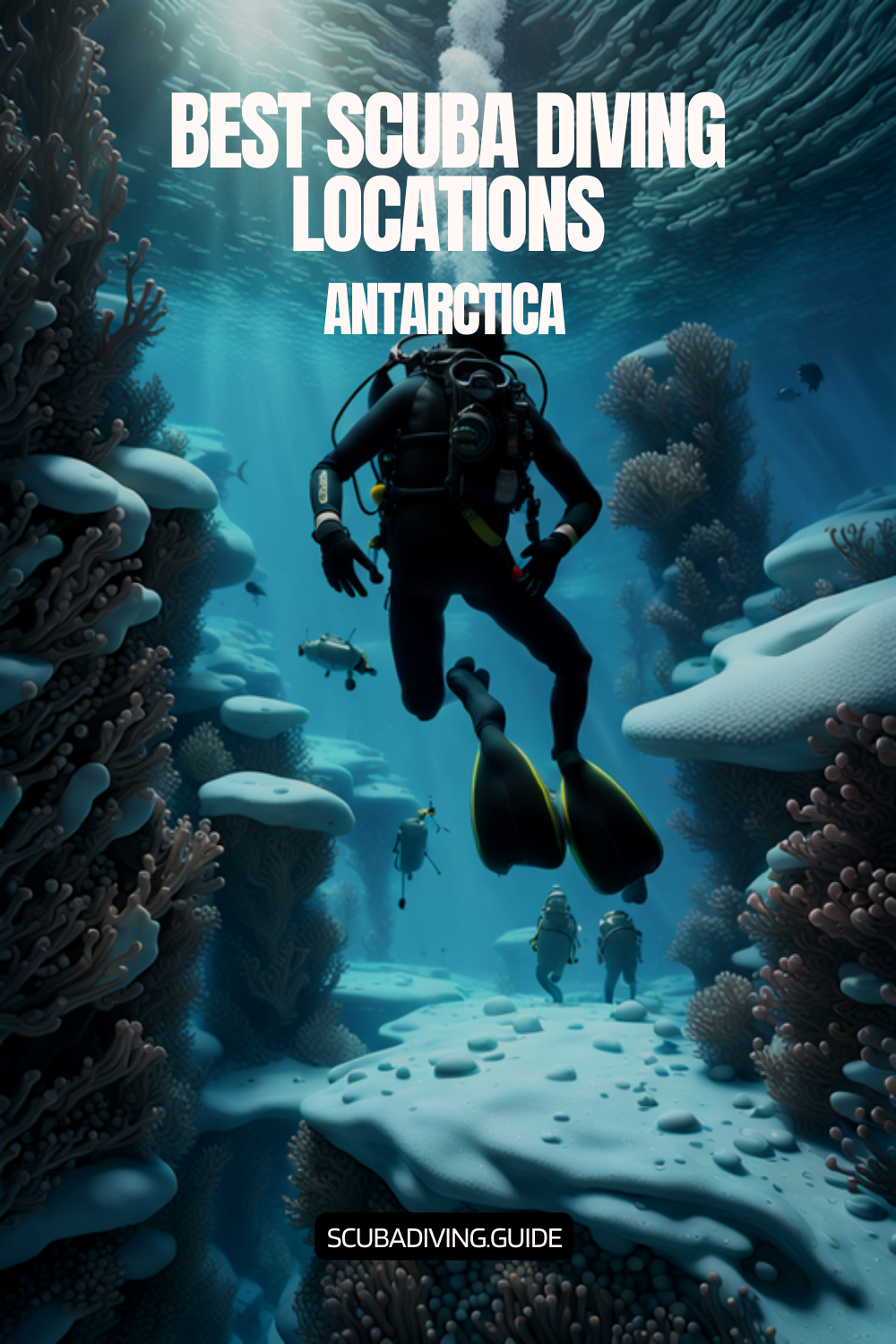
Introduction to Scuba Diving in Antarctica
Antarctica is the ultimate adventure for scuba diving. It has an underwater world that is both challenging and inspiring. The water is very cold, ranging from -2 to 2°C, making it a special place for divers.
Thanks to sustainable tourism, diving in Antarctica is now a managed experience. It lets divers see one of the most isolated places on Earth. This is a chance to explore a unique marine ecosystem.
Overview of the Antarctic Environment
The underwater world of Antarctica is amazing. It’s filled with ice and life. Key features include:
- Ice sheets that are over 4 km thick
- Visibility that can be very far
- Unique ice structures under the water
- Coastal temperatures can go over +10°C in summer
Importance of Marine Conservation
“Diving in Antarctica is not just an adventure, but a responsibility to protect one of the world’s most fragile ecosystems.” – Antarctic Research Collective
Marine conservation is key in Antarctic diving. The Southern Ocean’s ecosystem is very delicate. Divers must follow strict rules and use minimal-impact practices.
| Conservation Parameter | Antarctic Diving Guidelines |
|---|---|
| Maximum Divers per Tour | 12 participants |
| Diving Season | Late October to Late March |
| Required Experience | Minimum 20 dry suit dives |
By diving responsibly, adventurers help in understanding and saving this incredible marine environment.
Choosing the Right Time to Dive
Planning an Antarctic dive needs careful thought about the season. The Antarctic diving window is very short. It offers both challenges and amazing chances for Extreme Diving Adventures. Picking the best time can greatly improve your underwater adventure.
Seasonal Weather Variations
Antarctic diving is a unique challenge because of its very short exploration period. The best time for Antarctic Dive Photography is from November to March. During this time, the sea ice melts, and the water becomes clearer.
- November to March: Peak diving season
- Water temperatures range from -1.5°C to 2°C
- Underwater visibility often exceeds 30 meters
Prime Months for Underwater Sightseeing
Experienced divers suggest focusing on certain months for the best marine encounters and photos.
| Month | Diving Conditions | Wildlife Opportunities |
|---|---|---|
| December | Excellent visibility | Whale migration peaks |
| January | Warmest water temperatures | Penguin breeding season |
| February | Most stable ice conditions | Seal population at maximum |
“Antarctica offers a diving experience like no other – a true wilderness that challenges and rewards in equal measure.” – Antarctic Expedition Leader
Only 1% of Antarctic visitors dive, making it a rare Extreme Diving Adventures chance. It’s important to prepare well. You should have at least 50 practice dives and an advanced open water certification for a safe and unforgettable dive.
Essential Gear for Antarctic Diving
Getting ready for an Ice Diving Trip means you need special Cold Water Diving Gear. This gear must handle the harsh Antarctic environment. Choosing the right equipment and preparing well are key.
Diving in Antarctica’s icy waters needs top-notch gear. This gear keeps divers safe from temperatures as low as -2°C. The right gear can make your dive safe and exciting.
Wetsuits vs. Dry Suits: Choosing Your Protection
Choosing the right Cold Water Diving Gear for Antarctic trips is important. Dry suits are best for extreme cold. They keep you warmer than wetsuits.
- Dry Suits: Provide complete water isolation
- 7mm Neoprene Thickness: Recommended for Antarctic conditions
- Thermal Undergarments: Critical for maintaining body temperature
Additional Cold Water Equipment Essentials
Ice Diving Trips need more than just basic diving gear. You must be ready for the challenges of polar diving.
| Equipment | Specification | Purpose |
|---|---|---|
| Neoprene Hood | 3-5mm Thickness | Head and Neck Thermal Protection |
| Gloves | Thick Insulated Design | Hand Protection Against Cold |
| Regulators | Freeze-Protected | Prevent Freezing in Sub-Zero Temperatures |
“In Antarctica, your gear is not just equipment—it’s your lifeline.” – Professional Antarctic Dive Instructor
Here are some key recommendations for Cold Water Diving Gear:
- Minimum 20 previous diving experiences
- Dry suit certification
- Multiple regulator sets
- Advanced buoyancy compensation devices
Pro Tip: Always check your gear carefully before an Ice Diving Trip. This ensures you stay safe and perform well in extreme conditions.
Popular Diving Sites in Antarctica
Exploring Antarctica’s underwater world is a unique adventure. It’s a chance for scuba lovers to dive into the unknown. The icy waters offer a rare chance to see marine life up close.
To dive in Antarctica, you need special skills and gear. You must have:
- At least 30 dives in dry suits
- An international diving certification
- Experience diving in cold water
The Peninsula Diving Experience
The Antarctic Peninsula is a top spot for underwater adventures. Divers can see up to 80 feet in clear waters. The cold water, between 23 and 46 degrees Fahrenheit, makes it a unique challenge.
Weddell Sea Exploration
Weddell Sea is known for its rich marine life. Divers can see:
- Sea butterflies
- Kelp walls
- Giant isopods
- Diverse jellyfish species
“Antarctica represents one of the most extraordinary diving destinations on our planet.” – Professional Association of Diving Instructors CEO
| Diving Location | Unique Features | Average Visibility |
|---|---|---|
| Antarctic Peninsula | Dramatic Ice Formations | 40-80 feet |
| Weddell Sea | Rich Marine Ecosystem | 50-100 feet |
| South Shetland Islands | Wildlife Encounters | 30-70 feet |
Getting ready for an extraordinary underwater journey is key. The best time to dive is from November to March. It’s a short window to see these amazing underwater worlds.
Wildlife Encounters While Diving
Diving in Antarctica opens a window to a unique marine world. The Antarctic Marine Life is a mesmerizing underwater scene. It challenges and delights experienced divers. Get ready to be amazed by the incredible biodiversity in these cold waters.
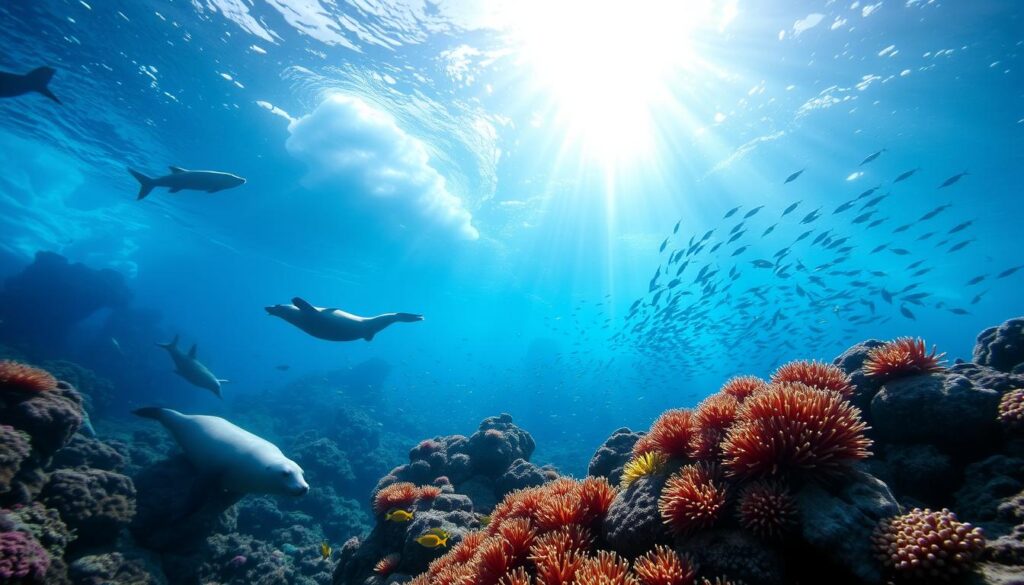
The underwater world of Antarctica is a breathtaking place of survival and adaptation. Temperatures around -1 degree Celsius make it a tough place for most creatures.
Common Species to Expect
Divers will have amazing Penguin Encounters Underwater. You might see:
- Gentoo penguins (30% of dive encounters)
- Curious baby elephant seals weighing around 150 kilograms
- Leopard seals in approximately 70% of wildlife-focused diving sessions
Unique Marine Life of Antarctica
The macro marine ecosystem is truly spectacular. It features incredible creatures like:
- Giant isopods measuring up to 10 cm
- 34-armed starfish
- Antarctic bloodless fish with special anti-freeze proteins
“Antarctic waters are not just cold – they’re a living, breathing ecosystem of remarkable adaptations and survival strategies.” – Marine Biologist Research Team
When diving, respect these amazing creatures. Keep a safe distance and don’t disrupt their habitat. The magical world beneath Antarctic waters promises an unforgettable experience for those ready to explore its depths.
Safety Precautions for Antarctic Diving
Extreme Diving Adventures in Antarctica need a lot of preparation and a strong focus on safety. The cold environment poses special challenges. Divers must be very well-trained and mentally ready for any risks.
Understanding the Diving Risks
When diving in Antarctic waters, the right gear is essential. Divers face several risks:
- Water temperatures range from -5 to 8°C (23 to 46°F)
- No decompression chambers are available in the area
- Medical help and evacuation options are limited
- Ice and visibility can change quickly
Emergency Protocols and Preparation
For safe Antarctic diving, careful planning and strict safety rules are key. Important safety steps include:
- At least 30 cold water dry-suit dive certifications
- An advanced Open Water international diving certificate
- Medical clearance within the last two years
- Maximum dive depth is 20 meters (65 feet)
“In Antarctica, survival depends on preparation, not luck.” – Professional Polar Diving Instructor
Dive operators follow strict safety rules. They limit groups to 24 diving passengers and keep a maximum of 6 divers per guide. Each Zodiac expedition watches the environment closely to keep divers safe during these extreme dives.
Finding a Reputable Dive Operator
Choosing the right dive operator for Polar Diving Expeditions is key. It ensures a safe and memorable Antarctic adventure. Sustainable Polar Tourism requires picking experienced professionals who focus on diver safety and protecting the environment.
Essential Qualities of Top Dive Operators
When picking a dive operator, look for these important qualities:
- Extensive polar region diving experience
- Proven safety record in extreme environments
- Commitment to environmental protection
- Highly qualified and experienced guides
- State-of-the-art diving equipment
Diving Certification and Experience Requirements
Professional dive operators have strict requirements for participants. For Antarctic expeditions, divers need to meet certain qualifications:
- Minimum 30 previous dive experiences
- Internationally recognized diving certification
- Recent medical clearance (within two years)
- Specialized cold-water diving training
“Safety and environmental respect are not optional in polar diving – they are absolute necessities.” – Professional Polar Diving Expert
Critical Safety Considerations
Antarctic diving comes with unique challenges. Reputable operators know these risks and follow strict safety rules. Important factors include limited medical facilities, specialized equipment needs, and precise diving depth limits.
Water temperatures range from 0 to -1.5 degrees Centigrade. This demands top preparation and skill from both divers and operators.
Training and Certification Requirements
Extreme Diving Adventures in Antarctica need special training and strict certifications. Divers must get ready well to face the tough polar underwater world. The unique needs of Cold Water Diving Gear and Antarctic conditions require deep preparation.
Experts say specific certifications are key for diver safety and knowing the environment. Those wanting to dive in Antarctica need training that’s more than just for fun diving.
Essential Certifications for Cold Water Diving
Divers must meet strict rules for Antarctic trips:
- Advanced Open Water certification
- Dry suit diving certification
- Minimum of 30 documented dry suit dives
- Rescue diver qualification
- First aid and CPR certification
Recommended Training Programs
Special training gets divers ready for polar underwater challenges:
| Training Program | Focus Area | Duration |
|---|---|---|
| Ice Diving Specialization | Cold water techniques | 3-5 days |
| Advanced Buoyancy Control | Precision underwater movement | 2 days |
| Polar Marine Ecology | Environmental awareness | 1 week |
“Preparation is the key to survival in Antarctica’s unforgiving underwater world.” – Antarctic Diving Experts
Divers must be truthful about their experience. The Antarctic environment is harsh and unforgiving. Good training can save an expedition from disaster.
Environmental Considerations
Antarctica is a pristine wilderness that needs special care and respect. Sustainable Polar Tourism aims to protect the delicate marine ecosystem in these extreme conditions.
The Antarctic environment is very fragile. Its unique marine life depends on precise ecological balances. Divers play a key role in protecting this ecosystem through responsible practices.
Protecting the Fragile Ecosystem
Keeping Antarctica’s marine environment safe involves understanding its complex vulnerabilities. Key challenges include:
- Minimizing human-induced disturbances
- Preventing invasive species introduction
- Reducing environmental contamination
- Maintaining wildlife habitat integrity
“Every dive is an opportunity to protect, not just explore.”
Responsible Diving Practices
Sustainable diving in Antarctica requires careful attention to environmental protocols. Divers must follow practices that reduce their ecological footprint:
- Maintain strict buoyancy control
- Avoid touching marine organisms
- Use environmentally friendly equipment
- Follow designated diving guidelines
| Practice | Environmental Impact |
|---|---|
| Proper Buoyancy | Prevents seafloor damage |
| No Wildlife Interaction | Reduces stress on marine species |
| Chemical-Free Gear | Prevents ecosystem contamination |
By embracing these principles, divers become guardians of one of Earth’s most extraordinary marine environments.
How to Prepare Physically and Mentally
Extreme Diving Adventures in Antarctica need top-notch physical and mental prep. The harsh polar climate tests even the most seasoned divers. It calls for a detailed training plan and readiness strategy.
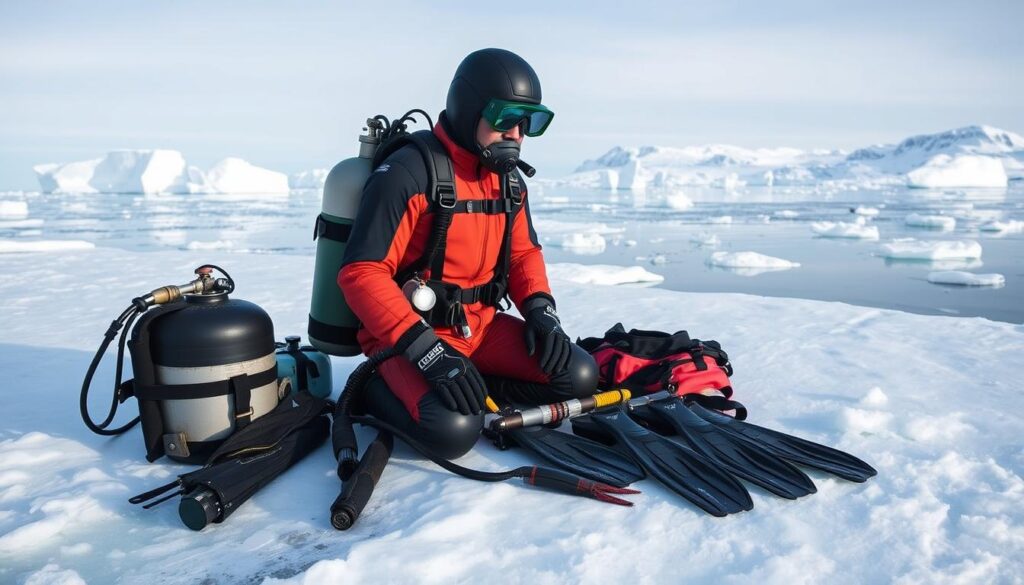
To get ready for Cold Water Diving Gear and extreme weather, you need to focus on several key areas:
Building Diving Endurance
Antarctic diving success hinges on physical conditioning:
- Cardiovascular training to boost lung capacity
- Strength exercises for core and upper body
- Cold water tolerance training
- Regular swimming with weighted gear
“Fitness is not just about strength, but adapting to extreme environments.” – Professional Polar Dive Instructor
Mental Readiness for Cold Conditions
Psychological prep is key for Extreme Diving Adventures. Divers need to work on:
- Stress management techniques
- Meditation practices
- Visualizing successful dives
- Building emotional resilience
Cold Water Diving Gear is vital for mental toughness. Understanding your gear well reduces fear and boosts confidence in tough spots. Antarctic divers should spend time getting to know their gear and practicing emergency drills.
Professional training and specialized certifications can greatly improve both physical and mental skills for polar diving.
After a Dive: Post-Diving Activities
Exploring Antarctica underwater is just the start. After diving, you can explore the continent’s untouched landscapes. This is a chance to see more of Antarctica through sustainable tourism.
It’s important to plan carefully after diving. Experts have set rules to keep divers safe and make sure they enjoy their time.
Recovery and Rest Protocols
- Wait at least 4-6 hours before doing anything hard
- Check how you feel after each dive
- Drink water and keep warm
Exploring Antarctic Landscapes
There are amazing things to do on land after diving. You can:
- Hike on glaciers
- Take photos of wildlife
- See research stations
- Go on snowshoeing trips
“The true Antarctic experience goes beyond diving. Each landscape has its own story of untouched nature and diverse life.” – Antarctic Expedition Research Team
Adventure Opportunities
| Activity | Duration | Difficulty Level |
|---|---|---|
| Glacier Trekking | 2-4 hours | Moderate |
| Wildlife Observation | 1-3 hours | Easy |
| Research Station Tour | 1-2 hours | Easy |
Sustainable tourism in Antarctica means exploring responsibly. Divers should choose activities that are good for the environment and educational.
Remember, safety is always first. Always listen to your guides and watch out for the local environment.
The Role of Scientific Research
Antarctic marine life research is key to understanding our planet’s ecosystems. Scientists work hard to learn about this untouched polar world. They explore how different parts of Antarctic marine ecosystems connect.
Sustainable polar tourism helps fund research in Antarctica. Diving trips help scientists gather important data on marine life and environmental shifts.
Contribution to Marine Biology
Marine biology research in Antarctica covers several important topics:
- Tracking climate change impacts on marine organisms
- Studying unique adaptations of Antarctic marine species
- Monitoring ecosystem health and biodiversity
The harsh Antarctic environment requires special research methods. Scientists use cutting-edge technology to study marine life in extreme conditions.
Citizen Science Opportunities
Diving fans can join scientific research through citizen science programs. These projects let underwater explorers help gather data while seeing Antarctic marine life up close.
| Research Program | Focus Area | Participant Involvement |
|---|---|---|
| Marine Life Survey | Species Identification | Underwater Photography |
| Ecosystem Monitoring | Environmental Changes | Data Collection |
| Biodiversity Tracking | Population Dynamics | Behavioral Observation |
“Every dive is an opportunity to contribute to our understanding of this fragile ecosystem.” – Antarctic Research Scientist
By joining these programs, divers turn their Antarctic trip into a scientific journey. They support vital research and see one of the world’s most amazing marine environments.
Testimonials and Experiences from Divers
Polar Diving Expeditions open a unique window into the world’s most untouched underwater places. Divers who have explored Antarctica’s waters say it’s a life-changing experience unlike any other.
Personal Stories from Expedition Participants
Diving in Antarctica is both challenging and incredibly rewarding. Professional divers share amazing stories of their underwater adventures:
- Water temperatures hover around 32.5 degrees Fahrenheit
- Visibility reaches up to 130 feet underwater
- They meet fascinating sea creatures like krill and seals
“Antarctic Dive Photography is not just about capturing images, but documenting an entire ecosystem in its most raw and pristine state.”
What to Expect: A Divers’ Perspective
Getting ready for a Polar Diving Expedition takes mental and physical toughness. Divers suggest:
- Wear multiple layers of thermal gear
- Practice cold water diving skills before
- Bring environmentally sealed regulator sets
The average expedition lasts 11 days, crossing tough waters like the Drake Passage. It offers many dive chances in March, the end of Antarctic summer.
Most divers find diving in Antarctica a once-in-a-lifetime adventure. It changes how they see marine environments.
The Cost of Diving in Antarctica
Polar Diving Expeditions are a big deal for those who love adventure. Diving in Antarctica is expensive. It needs careful planning and understanding of the costs.
The cost of diving in Antarctica is high. It reflects the unique challenges of this remote place. Divers should expect to spend a lot, more than usual diving trips.
Budgeting for Your Antarctic Adventure
Here’s a breakdown of the costs for this amazing experience:
- Liveaboard trip costs: About 750 USD per person per night
- Expedition duration: Usually 10-20 nights
- Required diving experience: At least 30 cold water dives
- Specialized gear rental or purchase
- Travel to departure point (usually Ushuaia, Argentina)
Understanding the Value of the Experience
“Antarctica offers a diving experience unlike any other location on Earth – pristine, untouched, and absolutely breathtaking.”
Though it’s expensive, Polar Diving Expeditions are worth it. Diving in Antarctica gives you:
- Exclusive access to untouched marine environments
- Unique wildlife encounters
- Personal growth from challenging experiences
- A chance to contribute to science
The cost is more than just money. It’s about creating unforgettable memories. For those seeking an unmatched underwater adventure, it’s priceless.
Antarctica Recommended Scuba Diving Itinerary
Crafting a well-planned scuba diving itinerary is essential for making the most of a diving expedition to Antarctica. This icy realm offers a wealth of breathtaking underwater experiences, and a thoughtfully designed itinerary ensures that divers can explore the best diving locations while maximizing their time in this unique environment. Here is a recommended scuba diving itinerary that encompasses some of the most remarkable sites in Antarctica:
Day 1: Arrival in Ushuaia, Argentina
The journey to Antarctica often begins in Ushuaia, the southernmost city in Argentina. Divers should plan to arrive in Ushuaia and check into their designated accommodation. This allows time to acclimate to the new surroundings, rest, and prepare for the upcoming adventure.
Day 2: Embarkation and Crossing the Drake Passage
Board the expedition vessel that will take you to Antarctica. The vessel sets sail from Ushuaia, crossing the legendary Drake Passage. During this two-day journey, divers can attend informative lectures, participate in safety briefings, and familiarize themselves with the vessel’s facilities.
Day 3-4: Drake Passage and Wildlife Spotting
As the vessel makes its way across the Drake Passage, keep an eye out for wildlife such as albatrosses, petrels, and whales. This is an excellent opportunity for photographers to capture stunning images of these magnificent creatures.
Day 5-7: South Shetland Islands
Arrive in the South Shetland Islands, the gateway to Antarctica. Dive sites in this region include Deception Island, where divers can experience the unique sensation of diving in steaming volcanic waters. Other sites like King George Island offer the chance to explore vibrant underwater ecosystems teeming with marine life.
Day 8-10: Antarctic Peninsula
Cruise southward to the Antarctic Peninsula, where divers will encounter breathtaking scenery and an abundance of marine life. Dive sites such as Paradise Bay, Neko Harbor, and Cuverville Island offer opportunities to explore vibrant kelp forests, encounter playful seals, and witness majestic icebergs.
Day 11-13: Gerlache Strait and Lemaire Channel
Continue exploring the Gerlache Strait and the renowned Lemaire Channel. These areas are known for their stunning landscapes and excellent diving conditions. Divers can explore underwater canyons, encounter a variety of fish species, and perhaps even come face-to-face with inquisitive penguins.
Day 14-15: Return Journey
Begin the journey back to Ushuaia, savoring the last moments in this pristine wilderness. Reflect on the incredible diving experiences and take the time to share stories and photographs with fellow divers.
Day 16: Disembarkation in Ushuaia
Arrive back in Ushuaia, concluding the expedition. Take some time to explore the charming city, visit local attractions, or simply relax and reflect on the unforgettable experiences of diving in Antarctica.
It’s important to note that this itinerary is a general guide, and the specific diving sites and order of exploration may vary depending on weather conditions, vessel capabilities, and other factors. Flexibility is key in Antarctica, as the region’s unpredictable nature requires adapting to changing circumstances.
Divers should always follow the guidance of the expedition leaders and diving professionals onboard, as they possess the local knowledge and expertise to ensure safety and maximize the diving experience.
By following this recommended itinerary, divers can embark on a once-in-a-lifetime journey, immersing themselves in the wonders of Antarctica’s underwater realm and creating memories that will last a lifetime.
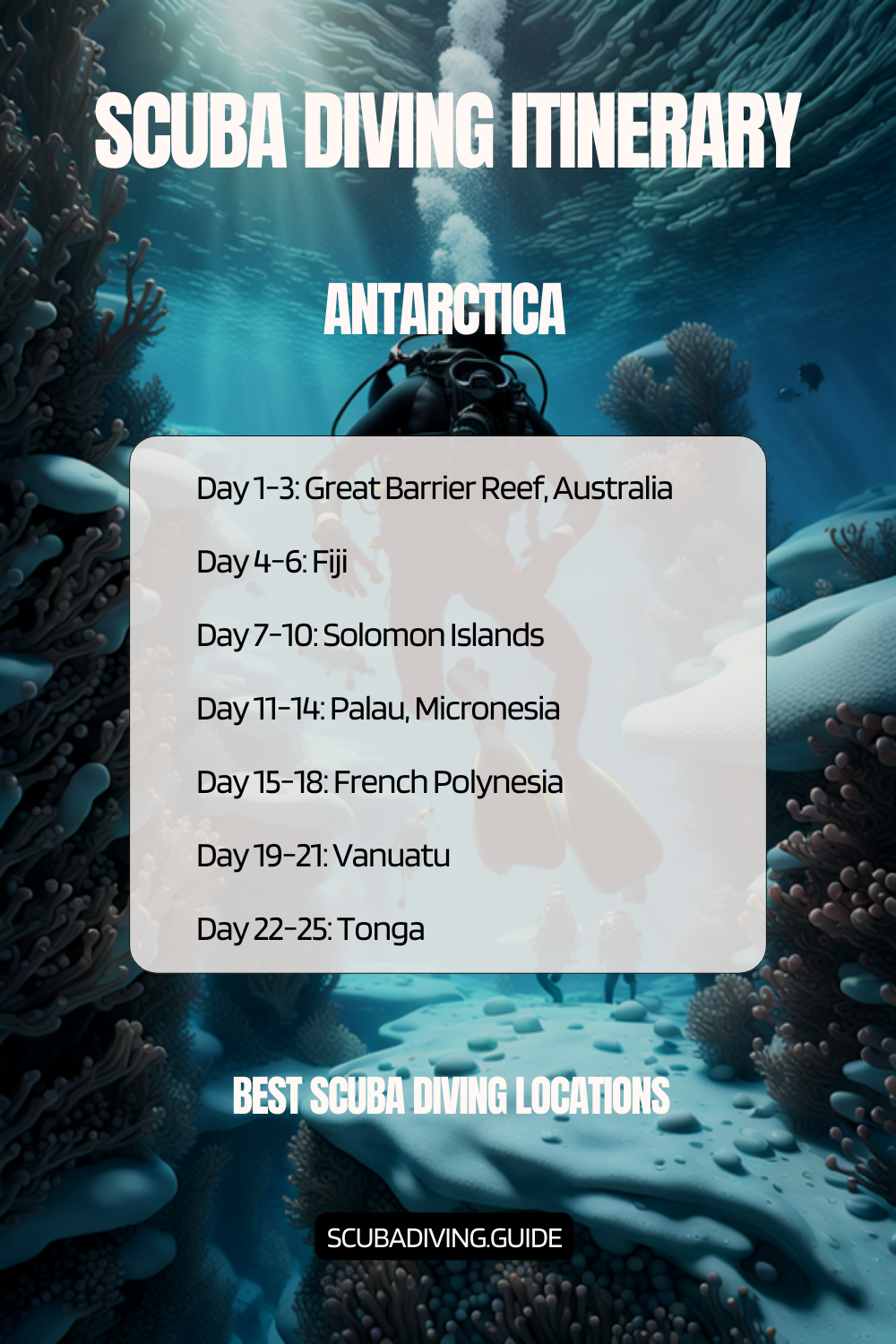
Conclusion: Why Dive in Antarctica?
Scuba diving in Antarctica is the ultimate adventure. It offers a unique underwater experience that pushes divers to their limits. You need 20-30 dives in cold water before you can go, and the water is so cold it can numb your skin fast.
The marine life in Antarctica is incredible. You might see huge sea spiders, starfish, sea urchins, and even whales. The underwater views, with ice formations and clear water, are unlike anything else in the world.
Summary of Key Points
Diving in Antarctica requires a lot of preparation and respect for the sea. The cold is extreme, and you need special skills and equipment. Divers must be in top shape and follow strict rules to protect the environment.
Call to Action for Adventurous Divers
If you’re ready for the ultimate dive in Antarctica, start getting ready. Look for good dive operators, get advanced cold-water certifications, and build your endurance. This adventure will change how you see the ocean forever.
FAQ – Scuba Diving in Antarctica
Is scuba diving in Antarctica safe for experienced divers?
Scuba diving in Antarctica is safe for those with lots of experience. They need advanced certifications and the right gear. Also, they must have training for diving in extreme cold.
Operators look for divers with dry suit certification and cold-water diving experience. This ensures safety in the harsh polar environment.
What marine life can I expect to see while diving in Antarctica?
Diving in Antarctica is a chance to see unique marine life. You might see sea butterflies, Antarctic fish, and kelp forests. There’s also a chance to see seals and penguins underwater.
Crab-eater seals, Weddell seals, and curious penguins might explore the underwater world with you.
What specialized equipment do I need for Antarctic diving?
You’ll need special cold-water gear for Antarctic diving. This includes a dry suit, thick thermal undergarments, and dry gloves. You’ll also need a cold-water hood and regulators for extreme temperatures.
Operators suggest a 200g thermal undersuit, dry gloves that keep warm, and a top-quality dry suit for polar conditions.
When is the best time to go diving in Antarctica?
The best time for diving in Antarctica is from late November to early March. This is the Antarctic summer. December to February is the best period.
During this time, the water is a bit warmer (28-32°F), there’s plenty of daylight, and wildlife is active.
How much does an Antarctic diving expedition cost?
Antarctic diving expeditions are pricey, costing between $10,000 to $25,000 per person. This includes expedition fees, travel, equipment rental, and guide services. Prices vary based on the operator, duration, and features.
What certifications are required for Antarctic diving?
You’ll need advanced diving certifications for Antarctic diving. These include: – Dry suit certification – Advanced open water diving qualification – At least 50 cold-water logged dives – Proof of recent diving activity – Ice diving specialty certification is highly recommended
How can I contribute to marine conservation during my dive?
You can help with marine conservation by: – Following strict no-touch protocols – Participating in citizen science programs – Using environmentally friendly diving practices – Supporting operators committed to sustainable tourism – Documenting marine life for research purposes
What are the primary safety risks in Antarctic diving?
The main safety risks are: – Hypothermia – Equipment failure in extreme cold – Limited emergency response capabilities – Disorientation in ice environments – Challenges with underwater visibility – Rapid changes in weather conditions
Do I need special physical preparation for Antarctic diving?
Yes, you need to be in top physical shape for Antarctic diving. This includes strong cardiovascular endurance, upper body strength, and cold water tolerance. You also need mental resilience and the ability to handle heavy diving gear.
Can beginners participate in Antarctic diving expeditions?
Most Antarctic diving expeditions are not for beginners. Operators look for divers with lots of cold-water experience and advanced certifications. Novice divers should gain experience in cold-water diving before going on an Antarctic expedition.
